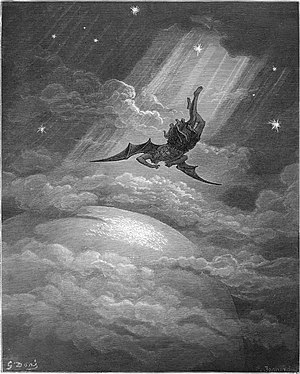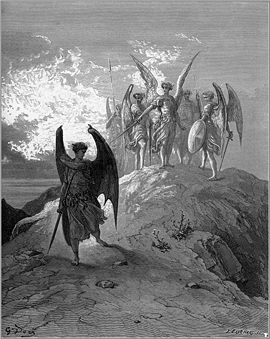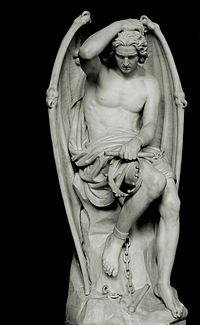Lucifer

Traditionally, Lucifer (/ˈluːsɪfər, ljuːsɪfər/) is a name that in English generally refers to the devil before being cast from heaven, although this is not the original meaning of the term. In Latin, from which the English word is derived, Lucifer means "light-bearer" (from the words lucem ferre). It was the name given to the dawn appearance of the planet Venus, which heralds daylight. For this meaning, English generally uses the names "Morning Star" or "Day Star", and rarely "Lucifer".
The Bible does not name the devil as Lucifer. The use of this name in reference to the devil stems from an interpretation of Isaiah 14:3–20, a passage that does not speak of any fallen angel but of the defeat of a particular Babylonian King, to whom it gives a title that refers to what in English is called the Day Star or Morning Star (in Latin, lucifer).[2] In 2 Peter 1:19 and elsewhere, the same Latin word lucifer is used to refer to the Morning Star, with no relation to the devil. It is only in post-New Testament times that the Latin word Lucifer was used as a name for the devil, both in religious writing and in fiction, especially when referring to him prior to his fall from Heaven.
Satan as Lucifer
The Lucifer story
An ancient myth[3] of the fall of angels, associated with the Morning Star, was transferred to Satan, as seen in the Life of Adam and Eve and the Second Book of Enoch,[4] which the Jewish Encyclopedia attributes to the first pre-Christian century:[5] in these Satan-Sataniel (sometimes identified with Samael) is described as having been one of the archangels. Because he contrived "to make his throne higher than the clouds over the earth and resemble 'My power' on high", Satan-Sataniel was hurled down, with his hosts of angels, and since then, he has been flying in the air continually above the abyss.[3]

Early Christian writers continued this identification of "Lucifer" with Satan. Tertullian ("Contra Marcionem," v. 11, 17), Origen (Homilies on Ezekiel 13), and others, identify Lucifer with Satan, who also is represented as being "cast down from heaven" (Revelation 12:7–10; cf. Luke 10:18).[3]
But today some contemporary exorcists and theologians, such as Father José Antonio Fortea and Father Amorth, asserted that Lucifer and Satan are different beings.[6]
In the New Testament the "adversary" has many names, but "Lucifer" is not among them. He is called "Satan" (Matt. 4:10; Mark 1:13, 4:15; Luke 10:18), "devil" (Matt. 4:1), "adversary" (1. Peter 5:8, ἀντίδικος; 1. Tim. 5:14, ἀντικείμενος), "enemy" (Matt. 13:39), "accuser" (Rev. 12:10), "old serpent" (Rev. 20:2), "great dragon" (Rev. 12:9), Beelzebub (Matt. 10:25, 12:24), and Belial (comp. Samael). In Luke 10:18, John 12:31, 2. Cor. 6:16, and Rev. 12:9 the fall of Satan is mentioned. The devil is regarded as the author of all evil (Luke 10:19; Acts 5:3; 2. Cor. 11:3; Ephes. 2:2), who beguiled Eve (2. Cor. 11:3; Rev. 12:9). Because of Satan, death came into this world, being ever the tempter (1. Cor. 7:5; 1. Thess. 3:5; 1. Peter 5:8), even as he tempted Jesus (Matt. 4). The Christian demonology and belief in the devil dominated subsequent periods.[7] However, though the New Testament includes the conception that Satan fell from heaven "as lightning" (Luke 10:18; Rev. 12:7-10),[8] it nowhere applies the name Lucifer to him.
The Jewish Encyclopedia states that in the apocalyptic literature, the conception of fallen angels is widespread. Throughout antiquity, stars were commonly regarded as living celestial beings (Job 38:7).[8] Indications of belief in fallen angels, behind which probably lies the symbolizing of shooting stars, an astronomical phenomenon, are found in Isaiah 14:12.
The Morning Star in Isaiah 14:12
The Book of Isaiah has the following passage:
When the Lord has given you rest from your pain and turmoil and the hard service with which you were made to serve, you will take up this taunt against the king of Babylon: How the oppressor has ceased! How his insolence has ceased! … How you are fallen from heaven, O Day Star, son of Dawn! How you are cut down to the ground, you who laid the nations low! You said in your heart, "I will ascend to heaven; I will raise my throne above the stars of God; I will sit on the mount of congregation on the heights of Zaphon; I will ascend to the tops of the clouds, I will make myself like the Most High." But you are brought down to Sheol, to the depths of the Pit. Those who see you will stare at you, and ponder over you: "Is this the man who made the earth tremble, who shook kingdoms, who made the world like a desert and overthrew its cities, who would not let his prisoners go home?[9]
The passage refers to the king of Babylon, a man who seemed all-powerful, but who has been brought down to the abode of the dead ("Sheol"). Isaiah promises that the Israelites will be freed and will then be able to use in a taunting song against their oppressor the image of the Morning Star, which rises at dawn as the brightest of the stars, outshining Jupiter and Saturn, but lasting only until the sun appears. This image was used in an old popular Canaanite story that the Morning Star tried to rise high above the clouds and establish himself on the mountain where the gods assembled, in the far north, but was cast down into the underworld.[3][10]
The phrase "O Day Star, son of Dawn" in the New Revised Standard Version translation given above corresponds to the Hebrew phrase "הילל בן־שׁחר" (Helel Ben-Shachar) in verse 12, meaning "morning star, son of dawn". As the Latin poets personified the Morning Star and the Dawn (Aurora), as well as the Sun and the Moon and other heavenly bodies, so in Canaanite mythology Morning Star and Dawn were pictured as two deities, the former being the son of the latter.[11]
In the Latin Vulgate, Jerome translated "הילל בן־שׁחר" (morning star, son of dawn) as "lucifer qui mane oriebaris" (morning star that used to rise early).[12] Already, as early as the Christian writers Tertullian and Origen,[10] the whole passage had come to be applied to Satan. Satan began to be referred to as "Lucifer" (Morning Star), and finally the word "Lucifer" was treated as a proper name. The use of the word "Lucifer" in the 1611 King James Version instead of a word such as "Daystar" ensured its continued popularity among English speakers.
Most modern English versions (including the NIV, NRSV, NASB, NJB and ESV) render the Hebrew word as "day star", "morning star" or something similar, and never as "Lucifer", a word that in English is now very rarely used in the sense of the original word in Hebrew (Morning Star), though in Latin "Lucifer" was a literal translation.
A passage quite similar to that in Isaiah is found in Ezekiel 28:1–19, which is expressly directed against the king of Tyre, a city on an island that had grown rich by trade, factors alluded to in the text.[13] In Christian tradition, it too has been applied to Lucifer, because of some of the expressions contained in it.[14] But, since it does not contain the image of the Morning Star, discussion of it belongs rather to the article on Satan than to that on Lucifer.

The same holds for the Christian depiction of Satan in other books of the Old Testament as, for instance, in the Book of Job, where Satan, who has been wandering the Earth, has a discussion with God and makes a deal with him to test Job.
The Tyndale Bible Dictionary states that there are many who believe the expression "Lucifer" and the surrounding context in Isaiah 14 refer to Satan: they believe the similarities among Isaiah 14:12, Luke 10:18, and Revelation 12:7–10 warrant this conclusion. But it points out that the context of the Isaiah passage is about the accomplished defeat of the king of Babylon, while the New Testament passages speak of Satan.[10]
In the Latter Day Saint movement
Some Mormon sects in the Latter Day Saint movement maintains that Lucifer was a name of Satan before he fell and was cast out of heaven. Accounts of the fall of Lucifer/Satan are found in several places within LDS canonical scripture, including the Doctrine and Covenants[15] and in the Pearl of Great Price.[16] The Book of Mormon also contains sections from Isaiah, including Isaiah 14:12-15.[17] The Book of Mormon version references the Latin translation of “morning star” as “Lucifer” that is used, in some versions of The Bible.
Use of the word "lucifer" in the Bible
The Vulgate (Latin) version of the Christian Bible used the word "lucifer" (with lower-case initial) twice to refer to the Morning Star: once in 2 Peter 1:19 to translate the Greek word Φωσφόρος (phōsphoros), a word, from φῶς (phōs) meaning "light" and φέρω (pherō̄) meaning "to carry", that has the same meaning of Light-Bringer that the Latin word has, and once in Isaiah 14:12 to translate the Hebrew word הילל (Hêlēl).[18] In the latter passage the title of "Morning Star" is given to the tyrannous Babylonian king, who the prophet says is destined to fall. This passage was later applied to the prince of the demons, and so the name "Lucifer" came to be used outside the Bible for the devil, and was popularized in works such as Dante Alighieri's Inferno and John Milton's Paradise Lost, but for English speakers the greatest influence has been its use in the King James Version of Isa 14:12 to translate the Hebrew word הילל, which more modern English versions render as "Morning Star" or "Day Star". A similar passage in Ezekiel 28:11–19 regarding the "king of Tyre" was also applied to the devil, contributing to the traditional picture of the fallen angel.
The Vulgate translation uses "lucifer" (Morning Star) twice to translate words in the Book of Job that meant something different: once to represent the word "בקר"[19] (which instead means "morning") in Job 11:17, and once for the word "מזרות" (usually taken to mean "the constellations") in Job 38:32. The same Latin word appears also in the Vulgate version of Psalms 110:3, where the original has "שׁחר" (dawn, the same word as in Isaiah 14:12).
The Vulgate did not use the Latin word lucifer to represent the two references to the Morning Star in the Book of Revelation . In both cases the original Greek text uses a circumlocution instead of the single word "φωσφόρος", and a corresponding circumlocution is used in the Latin. Thus "stella matutina" is used for "ὁ ἀστὴρ ὁ πρωϊνός" in Revelation 2:28, which promises the Morning Star to those who persevere, and for "ὁ ἀστὴρ ὁ πρωϊνός" (or, according to some manuscripts, "ὁ ἀστὴρ ὁ ὀρθρινός") in Revelation 22:16, where Jesus calls himself "the bright morning star".
The English word "Lucifer" is used in none of these places (other than Isaiah 14:12), where the Latin translation uses the Latin word "lucifer" (i.e., morning star).
Morning Star as Jesus Christ or the Virgin Mary
Outside the Bible, the Roman Rite liturgy's Exultet chant in praise of the paschal candle refers to Christ as the Morning Star (in Latin, lucifer, with lower-case initial):
|
May the Morning Star which never sets |
Flammas eius lucifer matutinus inveniat: |
Among Marian devotees, the Blessed Virgin Mary is also referred to as "Star of the Morning" and "Light of Dawning" in the hymn "Mary Immaculate, Star of the Morning". A popular Marian novena hymn attributed to the Wednesday Novena to Our Lady of Perpetual Help reads the following stanza lines:
"Mary Immaculate, Star of the Morning
Chosen before the creation began
Destined to bring, through the Light of your Dawning
Conquest of Satan, and rescue to Man..."
Another Marian reference to the Blessed Virgin Mary as the Morning Star is found in the Litany of Loreto approved by Pope Sixtus V. While the reference reads "Stella Matutina", the same similar reference of Star of the Morning is expressed through the following lines:
... Ianua caeli (Gate of heaven)
... Stella matutina, (Morning star)
... Salus infirmorum (Health of the Sick)
Astronomical significance
Because the planet Venus is an inferior planet, meaning that its orbit lies between the orbit of the Earth and the Sun, it can never rise high in the sky at night as seen from Earth. It can be seen in the eastern morning sky for an hour or so before the Sun rises, and in the western evening sky for an hour or so after the Sun sets, but never during the dark of midnight.
It is the brightest object in the sky after the Sun and the Moon. As bright and as brilliant as it is, ancient people did not understand why they could not see it at midnight like the outer planets, or during midday, like the Sun and Moon. It outshines the planets Saturn and Jupiter, which do last all night, but it soon disappears. Canaanite mythology has a story of an unsuccessful attempt by Athtar, the Morning Star pictured as a god, to take over the throne of Baal.[20][21]

"Lucifer" as Latin name for the Morning Star
In Latin, the word "Lucifer", meaning "Light-Bringer" (from lux, lucis, "light", and ferre, "to bear, bring"), is a name used for the Morning Star (the planet Venus in its dawn appearances).[22] The word is used in its astronomical sense both in prose and poetry, but most poets personify the star in a mythological context.
The Taxil Hoax: Lucifer's alleged connection with Freemasonry
Léo Taxil (1854–1907) claimed that Freemasonry is associated with worshipping Lucifer. In what is known as the Taxil hoax, he claimed that supposedly leading Freemason Albert Pike had addressed "The 23 Supreme Confederated Councils of the world" (an invention of Taxil), instructing them that Lucifer was God, and was in opposition to the evil god Adonai. Apologists of Freemasonry contend that, when Albert Pike and other Masonic scholars spoke about the "Luciferian path," or the "energies of Lucifer," they were referring to the Morning Star, the light bearer,[23] the search for light; the very antithesis of dark, satanic evil. Taxil promoted a book by Diana Vaughan (actually written by himself, as he later confessed publicly)[24] that purported to reveal a highly secret ruling body called the Palladium, which controlled the organization and had a Satanic agenda. As described by Freemasonry Disclosed in 1897:
- With frightening cynicism, the miserable person we shall not name here [Taxil] declared before an assembly especially convened for him that for twelve years he had prepared and carried out to the end the most sacrilegious of hoaxes. We have always been careful to publish special articles concerning Palladism and Diana Vaughan. We are now giving in this issue a complete list of these articles, which can now be considered as not having existed.[25]
Taxil's work and Pike's address continue to be quoted by anti-masonic groups.[26]
In Devil-Worship in France, Arthur Edward Waite compared Taxil's work to what today we would call a tabloid story, replete with logical and factual inconsistencies.
See also "Lucifer and Satan" at the Grand Lodge of British Columbia and Yukon website.
Occult beliefs

In the modern occultism of Dolores North (alias Madeline Montalban) (died 1982)[28] Lucifer's identification as the Morning Star (Venus) equates him with Lumiel, whom she regarded as the Archangel of Light, and among Satanists he is seen as the "Torch of Baphomet" and Azazel.
In the Satanic Bible of 1969, Lucifer is acknowledged as one of the Four Crown Princes of Hell, particularly that of the East. Lord of the Air, Lucifer has been named "Bringer of Light, the Morning Star, Intellectualism, Enlightenment."
Author Michael W. Ford[29] has written on Lucifer as a "mask" of the Adversary, a motivator and illuminating force of the mind and subconscious.[30]
Gallery
-
Lucifer, by Alessandro Vellutello (1534), for Dante's Inferno, canto 34
-
Lucifer, by William Blake, for Dante's Inferno, canto 34
-
cover of 1887 edition of Mario Rapisardi's poem Lucifero
-
Lucifer before the Lord, by Mihály Zichy (19th century)
-
Gustave Dore, illustration to Paradise Lost, book IX, 179-187
-
Mayor Hall and Lucifer, by an unknown artist (1870)
-
The planet Venus, either as the Morning Star (in Latin, Lucifer) or as the Evening Star (in Latin, Hesperus)
Millenium ideas about Lucifer
Lucifer was ressurected in the year 1998 in human form, otherwise known as the year (666×3), he was the head the first international computer network known as the BBS systems or BBS networks, Bulletin Board Systems which used Fidonet technology, thus he was the creator of the first Internet. He was born on the year of the reformer in astrological time & when he reached astrological maturity he was able to create a New Age which began to rise up in 1998, he was a bringer of knowledge, a bringer of change, a bringer of war & a bringer of peace, he was associated with the number 4 & was ruled by the number 5 & number 6.
See also
- Christianity
- Devil
- Earendel
- Eosphoros
- Iblis
- Inferno (Dante), the first of the three canticas of Divine Comedy
- Luceafăr
- Lucifer in popular culture
- Luciferianism
- War in Heaven
References
- ^ Milton's poem uses the name "Lucifer" only three times, as against 72 mentions of "Satan". The name used in this context is "Satan".
- ^ The word in the original text in Hebrew is הֵילֵל (transliteration: helel; definition: a shining one – Strong's Hebrew Numbers, 1966).
- ^ a b c d Jewish Encyclopedia: article Lucifer
- ^ Verses 29:4, 31:4 of the longer recension manuscript R
- ^ "The Lucifer myth was transferred to Satan in the pre-Christian century, as may be learned from 'Vita Adæ et Evæ' (12) and Slavonic Enoch (xxix. 4, xxxi. 4)" – article Lucifer
- ^ Jose [Fortea] Cucurull, Summa Daemoniaca 2004. (ISBN 84-933788-2-8)
- ^ Jewish Encyclopedia: article Satan
- ^ a b Jewish Encyclopedia: article Fall Of Angels
- ^ Isaiah 14:3–4, 14:12–17
- ^ a b c Tyndale Bible Dictionary (Carol Stream, Illinois 2001 ISBN 978-1-4143-1945-2), article Lucifer (p. 829)
- ^ "Verses 12–15 seem to be based on a Phoenician model. At all events, they display several points of contact with the Ras-Shamra poems: Daystar and Dawn were two divinities; the "mount of Assembly" was where the gods used to meet, like Mount Olympus in Greek mythology. The Fathers identified the fall of the Morning Star (Vulgate, Lucifer) with that of the prince of the demons" (note in the New Jerusalem Bible).
- ^ The Septuagint Greek translation of the phrase uses the same interpretation of "son of dawn": ὁ ἑωσφόρος ὁ πρωὶ ἀνατέλλων.
- ^ Your heart is proud and you have said, "I am a god; I sit in the seat of the gods, in the heart of the seas" … By your great wisdom in trade you have increased your wealth, and your heart has become proud in your wealth (verses 2 and 5)
- ^ With an anointed cherub as guardian I placed you; you were on the holy mountain of God; you walked among the stones of fire. You were blameless in your ways from the day that you were created, until iniquity was found in you. In the abundance of your trade you were filled with violence, and you sinned; so I cast you as a profane thing from the mountain of God, and the guardian cherub drove you out from among the stones of fire (verses 14–16).
- ^ Doctrine & Covenants 76:25-28 cf. Revelations 12:9
- ^ Moses 4:1-4
- ^ 2 Nephi 24:12-15
- ^ In the Greek translation of this passage the word used is Ἑωσφόρος – from ἔως, meaning dawn – which literally means Dawn-Bringer.
- ^ Hebrew text
- ^ John Day, Yahweh and the gods and goddesses of Canaan (Continuum International Publishing Group, 2002 ISBN 0826468306, 9780826468307), pp. 172–173
- ^ Gregory A. Boyd, God at War: The Bible & Spiritual Conflict (InterVarsity Press, 1997 ISBN 0830818855, 9780830818853), pp. 159–160
- ^ Lewis and Short
- ^ "Lucifer, the Son of the Morning! Is it he who bears the Light, and with its splendors intolerable blinds feeble, sensual, or selfish Souls? Doubt it not!" (Albert Pike, Morals and Dogma, p. 321). Much has been made of this quote (Masonic information: Lucifer).
- ^ Leo Taxil's confession
- ^ Freemasonry Disclosed April 1897
- ^ "Leo Taxil: The tale of the Pope and the Pornographer". Retrieved 14 September 2006.
- ^ Alternative Religions
- ^ Madeline Montalban and the Order of the Morning Star
- ^ Luciferwitchcraft.com
- ^ The Bible of the Adversary "Adversarial Doctrine" page 8 – Bible of the Adversary, Succubus Productions 2007).
Further reading
- Campbell, Joseph (1972). Myths To Live By. A Condor Book: Souvenir Press (Educational & Academic) Ltd. ISBN 0-285-64731-8







